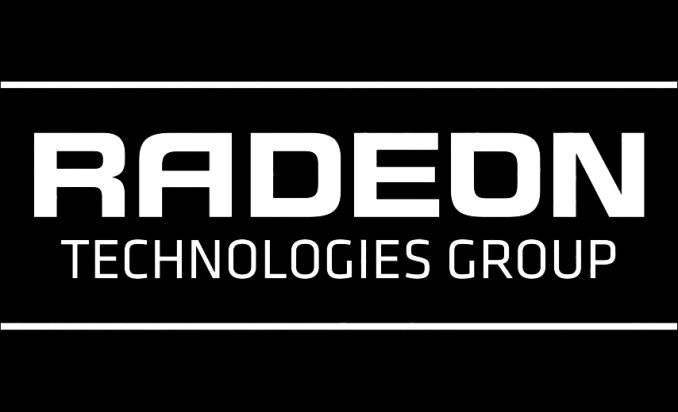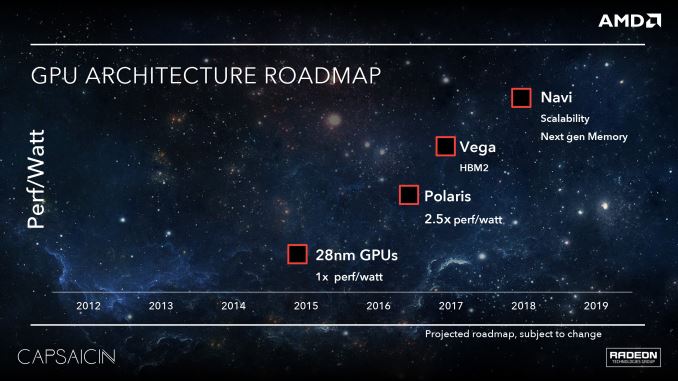AMD Unveils GPU Architecture Roadmap: After Polaris Comes Vega
by Ryan Smith on March 15, 2016 3:30 AM EST
Although AMD’s GDC 2016 “Capsaicin” event was primarily focused on game development – it is the Game Developers Conference, after all – AMD did spend a brief moment discussing their future GPU plans. For the first time in many years, AMD has published a GPU architecture roadmap.
Plotting perf/watt against the years, AMD’s roadmap unveils two new architectures: Vega, and Navi. Essentially everything there is to know about these architectures is in this slide – AMD is being tight-lipped regarding further details – but this map gives us some tantalizing new information to work with.
Vega is currently scheduled to come relatively quickly after Polaris. Depending on how literal you interpret this chart, the far left edge of the Vega box does fall into 2016, though obviously AMD intends to leave themselves some wiggle room here and not tie themselves down to specific dates. The fact that Vega comes this soon after Polaris is interesting; it seems hard to believe that it’s a direct successor to Polaris – I can’t see AMD replacing Polaris parts in less than a year – so this points to Vega being more of a cousin, and is where AMD’s naming system isn’t especially helpful in deciphering anything further.
With Polaris confirmed to use GDDR5, Vega is notable for being the first AMD architecture to use HBM2, and the first parts in general to use HBM tech since Fiji. I’m presuming these are higher-end GPUs to complement the Polaris GPUs (the smaller of which we know to be a low-power laptop design), which is where HBM would be more cost-effective, at least at current prices.
Meanwhile AMD has also confirmed the number of GPUs in the Vega stack and their names. We’ll be seeing a Vega 10 and a Vega 11. This follows Polaris GPU naming – which has finally been confirmed – with Polaris 10 and Polaris 11. I have also been told that Polaris 11 is the smaller of the Polaris GPUs, so at this point it’s reasonable to assume the same for Vega.
Finally, farther out towards 2018 is an architecture AMD is calling Navi. This one I suspect will attract the most attention (even if it’s the farthest out) due to the ambiguity of its features: “scalability” and “next gen memory”. Similar to how it’s hard to see Vega directly replacing Polaris, it’s hard to see Navi directly replacing Vega after only a year. This leaves Navi rife for speculation; I could very well see it being a Polaris replacement since we’ll be nearly 2 years past Polaris, or perhaps something to do with AMD’s APU plans. Either way I don’t expect that this will be the last time AMD teases it before finally launching it.

















54 Comments
View All Comments
OrenjiJuusu - Tuesday, June 7, 2016 - link
If we're to see high power 7nm necessary for GPUs in 2018 that means low power products would ship next year, and that's likely not the case.As for 'TSMC haters' they're mostly just the people who remember that the firm had trouble making deadlines well back into planar shrinks and think that they're full of it whenever they make claims of early launches of FinFET technology at problematic process sizes.
D. Lister - Tuesday, March 15, 2016 - link
Wow, AMD must be raking in a lot if cash recently and spending it all on R&D to be able to come up with so many new architectures in such a short period of time. Very nice.varad - Tuesday, March 15, 2016 - link
It hardly costs any money to make slides ;). Snide remarks aside, here's hoping we have healthy competition in the GPU world.D. Lister - Tuesday, March 15, 2016 - link
:) of course.toxicfiend1957 - Tuesday, March 15, 2016 - link
thumbs up i agreeZingam - Tuesday, March 15, 2016 - link
Slide-making is the top paid job ever.SaberKOG91 - Tuesday, March 15, 2016 - link
It's just an incremental design process. Polaris is a 16nm design sticking with the GDDR5 interface. Vega will likely be the high end replacements for the Fury line with the new 16nm architecture from Polaris and an HBM2 memory controller. Expect any alterations to Polaris from Vega to trickle down to the mid-year cards in 2017 (possibly HBM1/2). With Navi replacing the Vega Fury line in late 2017/ early 2018 with either an improved HBM2 interface, or the replacement to HBM2.DanNeely - Tuesday, March 15, 2016 - link
I'm reading elsewhere that Polaris was designed to support GDDR5/HBM1/HBM2."Earlier this year AMD confirmed to us that while it is still committed to the High Bandwidth Memory technology it co-invented with SK Hynix and brought to the market last year, Polaris was designed to be compatible with both HBM/HBM2 and GDDR5 memory standards. Technical marketing lead at AMD Robert Hallock explained that the company has the flexibility to use either technology as needs arise. This means that either memory technology can be employed where it makes sense."
http://wccftech.com/amd-unveils-polaris-vega-navi-...
With HBM2 delayed until Vega, I'd assume we'll see some higher end Polaris parts with HBM1. Hopefully with 8gb instead of only 4.
SaberKOG91 - Tuesday, March 15, 2016 - link
Press conference said GDDR5 for Polaris. Vega is most likely Polaris with HBM and some efficiency tweaks (think Tonga).I'm going off of previous release cycles where AMD puts out the affordable consumer models first (260X and 290X), and then launches enthusiast models later (295X2). June is way too soon to replace Fury. This is why Vega will be later this year, early next.
trane - Tuesday, March 15, 2016 - link
It does look like the Polaris generation is split into Vega and Polaris. I wonder if it's a possibility that AMD will go without a high-end GPU till Vega? Clearly for a high-end Finfet GPU 4GB is not enough any more, and GDDR5X is too slow. I'm guessing it was their plan to deliver the Polaris high-end GPU with HBM2 but due to HBM2 being delayed now that has been moved to Vega. Pretty sure they did similar reschedules with Fiji due to 20nm being bust and HBM delayed.Nvidia is probably doing the same. GP104 with G5X this year, GP100 with HBM2 next to take on Vega.